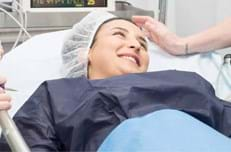General Anaesthetic - Intravenous Sleep Sedation - Regional Anaesthesia - Local Aesthetic
Anaesthesia is the insensitivity to pain artificially induced by the administration of gasses or the injection of drugs before a surgical procedure or medical procedures or tests. All types of anaesthesia are administered to keep the patient comfortable and pain-free.
There are 4 types of Anaesthesia:
- General Anaesthesia:
General anaesthesia is the highest level of sedation. There are many types and levels of this type of anaesthesia. While under general anaesthesia, you will be completely unconscious and many bodily functions (ie breathing) will need artificial assistance. - Intravenous Sleep Sedation:
Depending on the procedure, the level of sedation may range from minimal (you’ll feel drowsy but are able to talk) to deep (asleep). The difference with general anaesthesia is that breathing may be slow but the patient will never be reliant on artificial breathing. A few hours after the procedure the patient is back to normal and has been spared from the side effects and complications of general anaesthesia. - Regional Anaesthesia:
Regional Anaesthesia is a type of pain management that numbs large parts of the body (ie from the waist down) whilst keeping the patient fully conscious. This type of anaesthetic includes spinal blocks and epidurals but is uncommon in cosmetic surgery. - Local Anaesthesia:
Local anaesthetic is a one-time injection of medicine that numbs a small area of the body while keeping the patient fully awake and conscious. This type of anaesthetic is usually used for minor (less invasive) surgeries or in combination with another type of anaesthesia.
The importance of fasting before being subjected to Anaesthesia
If you have eaten, there is a chance that gastric fluid will enter the lungs when you are anaesthetised. Therefore, you should always be nil by mouth before having intravenous sedation or a general anaesthetic. Eating, drinking or smoking is strictly prohibited up to eight hours before surgery.













































